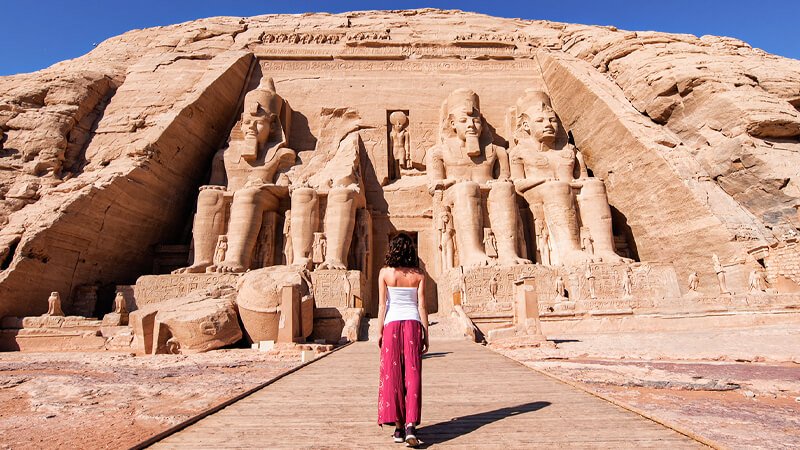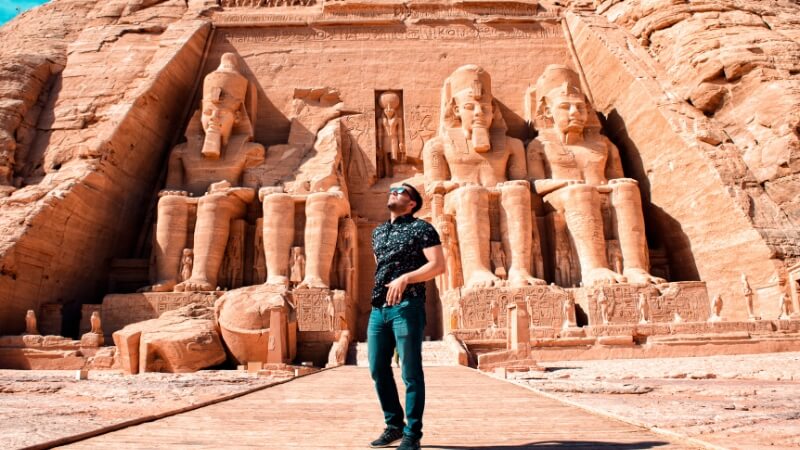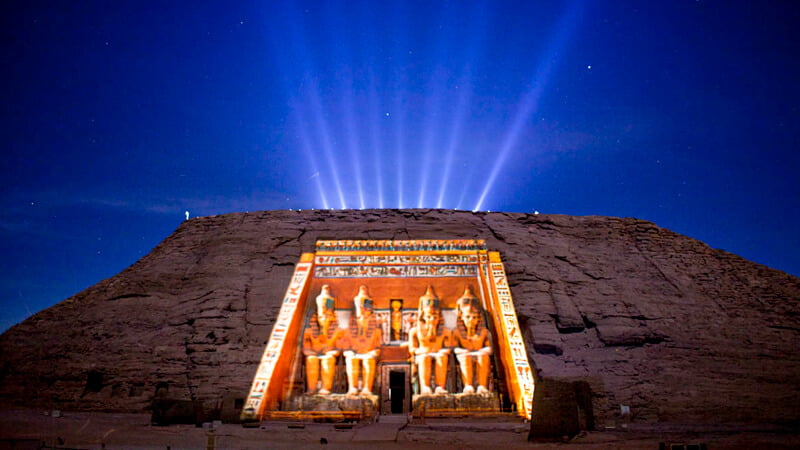Have you ever wondered about Egypt’s rich history? The colossal statues and intricate sculptures are just a few examples of the wonders you’ll see, making any visit to this site an unforgettable experience.
The Great Temple of Ramses II at Abu Simbel is a unique architectural masterpiece. Located in southern Egypt, it is renowned for its immense size and historical significance.
A visit to this site will allow you to learn about its construction and the legends surrounding Ramses II. The temple’s architectural design and the beauty of the surrounding natural landscape create an unforgettable experience.
The Magnificent Abu Simbel Temple: An Overview
Abu Simbel was built during Ramses II’s reign. It’s a huge rock-cut temple that has amazed people for centuries. Ramses II built it to celebrate his victory at the Battle of Kadesh and to show Egypt’s strength.
The temple’s impressive architecture and detailed carvings show ancient Egypt’s rich history. You’ll see four huge statues of Ramses II at the entrance. They symbolize the pharaoh’s power and his divine status.
So, why is the Abu Simbel temple important? It’s not just a sign of ancient Egyptian skill and creativity. It’s also a key historical site saved for the future. The temple complex, including the smaller one for Nefertari, Ramses’ wife, gives us a peek into the past.
A paragraph about Abu Simbel temple wouldn’t be complete without mentioning its move in the 1960s. This was to save it from being lost under Lake Nasser. This huge effort showed global teamwork and a wish to keep cultural treasures safe.
In summary, Abu Simbel temple is a top spot for history, architecture, or Egypt’s cultural heritage fans. Its grandeur and historical importance make it a memorable visit.
Historical Background: Who Built the Abu Simbel Temple and When
Ramses II, a powerful pharaoh of Egypt, built the Abu Simbel temple. This huge project happened during the 19th Dynasty of Ancient Egypt, from 1264 BCE to 1244 BCE. It was made to celebrate Ramses II’s win at the Battle of Kadesh and show his divine power.
Building Abu Simbel was a big job that needed lots of resources and workers. The temple was carved directly into the sandstone mountains. This shows the advanced engineering skills of the ancient Egyptians. The history of Abu Simbel is closely linked to Ramses II, who ruled for over 60 years and left a big mark on Egypt.
Some important historical facts about Abu Simbel are:
- The temple was built during a time of peace and prosperity under Ramses II.
- Abu Simbel was made to honor the gods Amun and Ra, and Ramses II himself.
- The temple’s construction shows the amazing architectural and engineering skills of ancient Egypt.
Knowing who built the Abu Simbel temple and when it was built gives us a better understanding of Ancient Egypt’s history and culture during the 19th Dynasty. The temple is a symbol of Ramses II’s greatness and achievements.

Location and Geography: Where is the Temple of Abu Simbel Located
The Abu Simbel Temple sits on the edge of Lake Nasser. It’s a key historical spot in Egypt, near the Sudanese border. This temple is on the western bank of Lake Nasser, made by the Aswan High Dam.
In ancient times, Abu Simbel showed Egypt’s power. The temple’s alignment with the sun on special days was also important. Now, it draws visitors from everywhere.
Abu Simbel’s geography is unique:
- It’s close to the Sudanese border, showing its historical role.
- The temple’s location on Lake Nasser shows ancient Egyptian engineering.
- The area is vast deserts and an artificial lake.
Abu Simbel’s geography makes it a must-see for travelers and historians.
Architectural Marvel: The Impressive Size and Design
As you get close to the Abu Simbel temple, its huge size and detailed design will amaze you. It was built by Ramses II. It shows the amazing skills of the ancient Egyptians in building.
The colossal statues at the entrance are over 65 feet tall. They show Ramses II and other gods. These statues were carved into the sandstone mountainside. It shows how advanced the ancient Egyptians were.
When you go inside, you see a big hypostyle hall. It’s filled with intricate carvings of myths and Ramses II’s battles. Inside, statues of gods like Amun and Ra-Horakhty show the temple’s deep religious meaning.
- The temple’s design shows a deep understanding of astronomy. Twice a year, the sun shines into the inner sanctum.
- The reconstruction of the temple is also impressive. It was moved to save it from Lake Nasser. This shows modern engineering skills.
- The details and huge size of Abu Simbel make it a memorable visit for everyone.
The Abu Simbel temple is not just a wonder in architecture. It’s also a key historical site. It gives us a peek into ancient Egyptian culture and beliefs. Its size and design still draw visitors from all over.
Religious and Political Significance of Abu Simbel
Exploring Abu Simbel reveals its deep religious and political roots. The temple honors gods Amun, Ra-Horakhty, and Ptah. Ramses II built it to show his divine right to rule, blending religion and politics.
The temple’s design and statues highlight Ramses II’s divine connection. The four giant statues at the entrance symbolize his divine status. Inside, intricate carvings and hieroglyphs show Ramses II in divine roles, emphasizing his religious importance.
Politically, Abu Simbel showcased Ramses II’s power and Egypt’s wealth. Building such a massive temple in a remote area showed the king’s vast resources and labor control. Abu Simbel was a symbol of Egyptian might, showing the pharaoh’s power to neighbors.
Today, Abu Simbel is a cultural and archaeological gem, drawing global visitors. Its lasting importance celebrates Ramses II’s legacy and the ideals he stood for.

The Incredible Solar Phenomenon at Abu Simbel
The temple of Abu Simbel is famous for a special solar event. It happens twice a year, on February 22 and October 22. On these days, the sun shines just right into the temple’s inner part.
This event shows how smart the ancient Egyptians were. They knew a lot about astronomy and building. The solar alignment was planned with care. It lights up three statues of Ramses II, Ra-Horakhty, and Amun.
The Abu Simbel sun festival is a big deal. People from everywhere come to see it. It’s a chance to see how clever and devoted the ancient Egyptians were.
Seeing this solar event makes your visit to Abu Simbel even more special. It adds a deeper meaning to your experience.
The Remarkable Story of Abu Simbel’s Relocation and Reconstruction
In the 1960s, a big challenge was to save Abu Simbel from Lake Nasser’s rising waters. The Aswan High Dam was built, which would have covered the temples. UNESCO led a global effort to move them to safer ground.
Moving the temples was a hard task. The temples were broken into big blocks, some up to 30 tons. Then, they were put back together 65 meters higher and 180 meters back from where they were.
The steps to move them were:
- The site was carefully documented and excavated.
- The temples were cut into large blocks using a grid system.
- Each block was numbered and removed.
- The blocks were then reassembled at the new site.
This careful work kept the detailed carvings and structures safe.
The move showed how teamwork and engineering skills can save history. It was finished in 1968, and the temples were opened to visitors. Now, people can still be amazed by the effort to save Abu Simbel.
The story of Abu Simbel’s move is a great example of human creativity and teamwork. When you visit, you’ll see the importance of saving our cultural treasures.
Inside the Abu Simbel Temple: What to See and Photograph
When you enter the Abu Simbel Temple, you’ll see huge statues and detailed carvings. These tell the story of Ramses II. The Great Temple of Abu Simbel is a wonder that draws visitors from everywhere.
The inside of the temple is as amazing as the outside. You’ll see big statues of Ramses II and other gods. The walls have carvings that show the king’s battles and his faith. These carvings are beautiful and give us a peek into ancient Egyptian life.
While you’re in the temple, don’t forget to take pictures of:
- The huge statues of Ramses II at the entrance
- The detailed carvings on the walls, showing the king’s fights and religious acts
- The sacred room, filled with statues of gods
Photographing in the Abu Simbel Temple needs patience because of the light. But, the special feel and history make it worth it. Take your time to enjoy the view and get some great photos.
Seeing the Abu Simbel Temple inside is a memorable trip. It lets you see ancient Egypt’s history and amazing buildings. Be sure to take lots of photos to remember your visit.
Planning Your Visit: Best Time and Practical Information
To see the beauty of Abu Simbel, knowing the best time to go is key. The best time to visit Abu Simbel is from October to April. This is when the weather is cooler, perfect for exploring the temples.
Here are some key things to think about when planning your trip:
- Check the weather forecast before you go, as the temperature can change a lot.
- Book your Abu Simbel day trip from Aswan early to get a spot.
- Plan for early morning departures to enjoy your day fully.
Going to Abu Simbel as a day trip from Aswan is a favorite choice. Starting early helps you avoid the hot sun. You’ll also see the temples with fewer people around.
By planning well and being ready, you’ll have a great time at Abu Simbel.
How to Get to Abu Simbel: Transportation Options from Aswan and Cairo
To get to Abu Simbel, you have a few choices. You can fly from Aswan, or take a bus or private car from Aswan or Cairo. Your choice depends on how fast you want to get there, your budget, and what you like best.
Flights from Aswan to Abu Simbel are the quickest way. They take about 1 hour. This is great for those on an Abu Simbel day trip. Many airlines fly this route, with flights in the morning and afternoon. You can book online or through local travel agencies.
Or, you can take a bus or private car from Aswan or Cairo. This takes longer, about 8-10 hours from Aswan and more from Cairo. But, you get to see Egypt’s beautiful landscapes. This is good for those who like to travel slowly or are watching their budget.
When planning your trip, remember a few things:
- Check the latest schedules and availability early.
- Book your tickets early, too, to get a spot, even in busy times.
- Look into any extra things you might need, like visas or travel permits.
Choosing the right way to travel makes your trip to Abu Simbel better.

Tips for an Unforgettable Abu Simbel Day Trip
An Abu Simbel day trip is a once-in-a-lifetime experience. To make it truly special, here are some expert tips to guide you. To make the most of your visit, it’s crucial to plan ahead.
First and foremost, arrive early to beat the heat and the crowds. The temples are more enjoyable when it’s not too hot. You’ll have a better chance of taking great photos without the distraction of large groups.
Dress comfortably and be prepared for the sun. Bring essentials like sunscreen, a hat, and sunglasses. The desert climate can be unforgiving, so it’s vital to protect yourself.
- Plan your transportation in advance, whether it’s a guided tour or independent travel.
- Bring enough water and snacks to keep your energy up throughout the day.
- Take your time exploring the temples; there’s a lot to see and appreciate.
By following these tips, you’ll be well on your way to having an unforgettable Abu Simbel day trip. Enjoy your visit and make the most of this incredible experience.
Conclusion: Why Abu Simbel Remains an Essential Egyptian Experience
Abu Simbel shows the greatness of ancient Egypt. It draws visitors with its history, architecture, and nature. The temple is a key cultural and historical site, showing Ramses II’s power.
Exploring Abu Simbel reveals more than its size and carvings. Its move and rebuild show human creativity and the will to keep culture alive.
Seeing Abu Simbel is a rare opportunity to witness ancient Egypt’s glory. It has a rich history, amazing buildings, and stunning nature. Abu Simbel is a must-see for those who love Egyptian culture and history.
Read more related articles:




